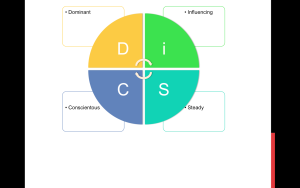How to Get Things Done Across Personality Chasms
Thursday night, I went to a workshop by my friend Ingrid Bredenberg, Essential Skills for 21st Century Leaders, put on by the graduate program in Leadership at American International College. Her curriculum was based on the DiSC personality matrix.
Short version: we often expect people to act as if they approach the world the same way we do—but actually, most people tend to emphasize certain personality traits and de-emphasize others. We fall into four sweeping personality categories, though with plenty of gray area and overlap. If you expect the same behavior patterns from someone with a different way of looking at the world, you both will be disappointed and frustrated.

The two axes measure whether a person is outgoing or reserved, and whether he or she focuses more on people or on tasks.
Dominants (D) are outgoing and very focused on results. They ask What questions, like “what has to happen to move this forward?”
Influencers (i) are also outgoing, but much more people-oriented. They ask Who questions, like “who should be part of the team?”
Steady (S) people are a lot quieter and dependable. When a D or i initiates a project, often it’s the S who gets it done. Look for How questions: “How can we accomplish this task?
And the Conscientious (C) are task-oriented introverts who ask Why questions, such as “why do we need to do this?”
The thing about personality traits is that they are strengths up to a point—but in overdrive, they become weaknesses. A super-intense D may turn lets-get-it-done into running roughshod over others and becoming a tyrant, while a super-C can turn caution into stubbornness, dig heels in and not move forward. A super-i could be annoyingly flighty even at a party, eventually, while a super-S might turn strong loyalty into blind obedience. (These are my examples, not Ingrid’s.)
Why does the i take a small letter when the other three are capitalized? Ingrid thought it might have been as simple as the need to make it clear that it was not a lower-case L. In the sans-serif typefaces that DiSC’s graphics people favor, those two look pretty similar.
As a marketer rather than a manager, I see implications far beyond running a meeting or tasking a project through an organization. Just as in the green world, I tell my clients to message differently to Deep Greens, Lazy Greens, and Nongreens, and just as many marketers tell you to market differently to people who learn by sight, sound, or touch (visual, aural, or kinesthetic), so it’s important to reach the different personality styles with messages that resonate with each.

